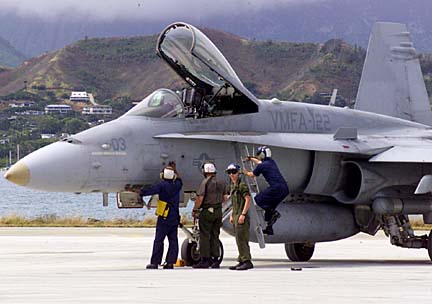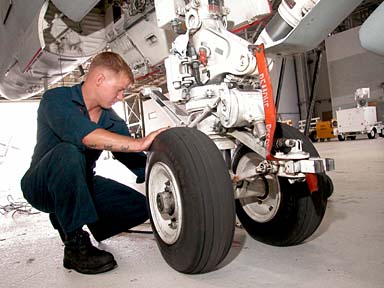
CRAIG T. KOJIMA / CKOJIMA@STARBULLETIN.COM
A Marine Hornet squadron from South Carolina has been at Kaneohe Bay since June 8, participating in one of three combined arms exercises that Kaneohe Marines conduct at the Big Island's Pohakuloa Training Area. One of the squadron's F-18 Hornets is seen here sitting at the Kaneohe base.
A long way from home
A Marine jet squadron training
in the islands has been deployed
for nearly a year
Since July, 160 Marines with Marine Fighter Attack Squadron 122 (VMFA-122) have been in Iwakuni near Hiroshima on a deployment that was supposed to have lasted only for six months, but was extended "indefinitely" because of the war in Iraq.
The extended deployment, now going into its 11th month, has caused hardships for many of the unit's younger enlisted members, said Capt. Regi Johnson, the unit's administrative officer.
Cpl. Jason Barkhurst, an airframe specialist, said he was forced to cancel the lease of a home with his wife, Dawn, in Beaufort, S.C., where the F-18C Hornet squadron is located.
"She was so disappointed," said Barkhurst, 23, "she cried" when she learned just after New Year's Day that "we weren't coming home as anticipated." The two have been married for two years.
Johnson, 33, said that two F-18 squadrons from Beaufort "were sent to the war. One of them was supposed to have relieved us. That's why we got stuck in Japan."
"I am single," said Johnson, a Hornet fighter pilot since 1994, "so it wasn't so bad. It was tougher on the younger Marines. We have young Marines with young relationships; some of them have been married less than a year. It was rough on them."
"So we tried to be creative."
Johnson said that when one of the unit's 12 Hornet jet fighters had to be sent back to the mainland for repairs recently, it was decided to give some of the younger Marines seats on an accompanying 707 jet tanker. "That way they would only have to pay for a round trip ticket to Beaufort from San Diego."
For Johnson and other aviators in the VMFA-122, missing the war also was a disappointment.
But Johnson said the unit knew that their mission in the western Pacific was of equal importance.
The Marine Hornet squadron has been at Kaneohe Bay since June 8, participating in one of three Hawaii combined arms exercises that Kaneohe Marines conduct at the Big Island's Pohakuloa Training Area. The 10-day exercise ended Friday, and the South Carolina aviators will return to Iwakuni at the end of this month.
CRAIG T. KOJIMA / CKOJIMA@STARBULLETIN.COM
Cpl. Jason Barkhurst, an airframe specialist, works on an F-18 Hornet. He was forced to cancel a visit home after his deployment was extended due to the war in Iraq.
From there they hope to start preparing for the final 6,000 mile return trip home.
More than 1,200 Kaneohe Bay Marines from the 2nd Battalion, 3rd Marine Regiment; Marine Heavy Helicopter Squadron 362; a detachment from Combat Service Group 3; and artillery men from Bravo Battery, 1st Battalion, 12th Marine Regiment are participating in the training.
Staff Sgt. Robert Carlson, Kaneohe Bay Marine Corps spokesman, said the exercise gives the Marines a chance to train and fight in a typical Marine Air Ground Task Force alignment with the South Carolina Hornet squadron making up the air combat element.
"The ground combat element is composed of the Marines from Kaneohe," Carlson said. "This is the way the Marines fought in Iraq."
As part of the exercise, the Marines from Kaneohe loaded their trucks, generators and equipment onto an Army transport ship that pulled into Kaneohe Bay and then shipped out to the Big Island.
"This kind of training benefits everyone," Carlson said, "since they have to practice loading and unloading their equipment, and then they get to fire their weapons."
Johnson said the live-fire range at PTA allows the Hornet pilots to drop live bombs, some as heavy as 500 pounds, as well as inert munitions.
"We also practice giving aerial support for downed pilots," Johnson added.
The Hornets provide aerial cover at about 15,000 feet to ensure that the rescue helicopters aren't attacked. "We make sure that there are no air threats from above," he said.
He estimated that the 11 Hornets temporarily stationed at Kaneohe Bay will fly about 160 missions to the Big Island during their month-long stay on Oahu.
Marine Fighter Attack Squadron 122 was commissioned on March 1, 1942, and was called the "Candy-stripers" when it was sent to the Pacific campaign outfitted within F-4F Wildcats. Under the command of World War II ace Maj. Gregory "Pappy" Boyington, the squadron, after transitioning to F-4U1 Corsairs, the unit accounted for 35 1/2 kills.
It formed the Marines' first and only aerial demonstration team called the "Flying Leathernecks" and toured the country for nearly 10 years, flying FH-1 Phantoms. The squadron became known as Crusaders when it received its first five F-8U Crusader jet fighters. It was deployed to Vietnam in August 1967.
For a brief time the squadron was stationed at Kaneohe Bay in 1970 and again in 1972.
Once the squadron returns to South Carolina next month, it will begin training for a deployment on an aircraft carrier 18 months from now.

